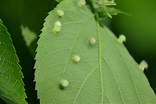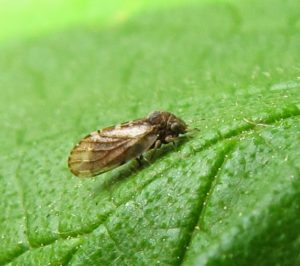Hackberry psyllids are small aphid-like insects that cause hackberry galls commonly seen on the underside of hackberry tree leaves. An alternative name is hackberry “gall-maker.” They are most commonly noticed, however, as a household nuisance in late summer and fall.

Psyllids (pronounced: Sill – ids) are called jumping plant lice. They resemble miniature cicadas and have powerful hind legs that allow them to jump and fly away quickly. The hackberry psyllids are 3/16″ long and have lightly colored wings mottled with tiny dark spots.

This species is specific to hackberry trees and does not develop anywhere else. Adults fly to hackberry trees in early spring and lay eggs in leaf buds. Eggs hatch into tiny nymphs that stimulate the raised galls or swellings in which the insect lives and feeds for the rest of the summer. Infested hackberry trees are not harmed by the galls.
When psyllids complete their development in late summer the adults leave the galls to pass the winter. They normally spend the winter in cracks and crevices of tree bark and other sheltered locations. However, like many other nuisance pests, they may be attracted to houses in the fall and enter into walls through cracks and gaps around windows or in the siding. From there they wander on indoors. This is when they can be a temporary but very aggravating annoyance. The size of the population and extent of the annoyance varies greatly from year to year.
Psyllids are annoying because of their presence. They do not feed on humans although some people report that they “pinch” when they land on exposed skin. They cannot sting and they do not carry disease. They will not attack pets, house plants, stored products, or furnishings.
Although psyllids can be very annoying, they are harmless and control may not be warranted. Effective control of adults in late summer and winter is very difficult to achieve. Household “ant and roach” sprays or dusts have limited effect on this pest.
Preventing psyllids by spraying hackberry trees before gall formation is sometimes suggested. Several applications of an insecticide would generally be necessary to have a noticeable effect. Thoroughly spraying large trees is a further complication. In short, there is little that is practical in the way of hackberry psyllid management other than to tolerate the occasional annoyance.
